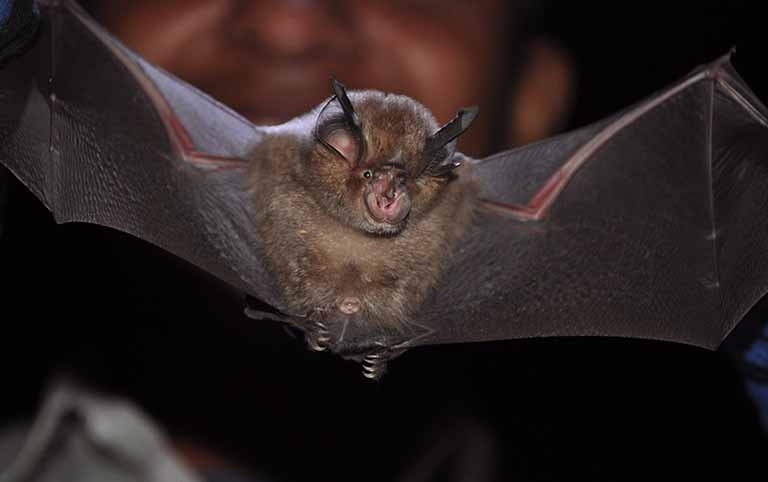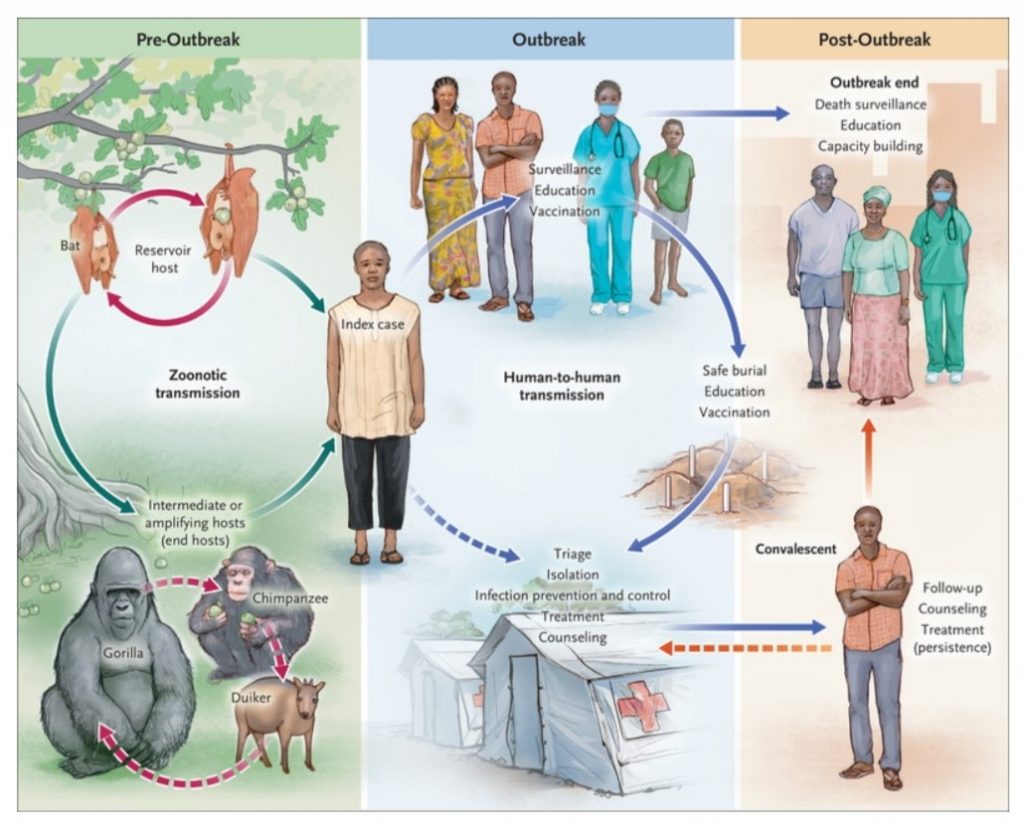Nepal urgently needs to research bats
- Nature Khabar

 Bat is one potential reservoir for a host of viruses that cause zoonotic diseases. But it is one area that is very little studied despite its threats to human health in general. Current Covid-19 crisis brings this topic to discussion.
Bat is one potential reservoir for a host of viruses that cause zoonotic diseases. But it is one area that is very little studied despite its threats to human health in general. Current Covid-19 crisis brings this topic to discussion.
Zoonotic diseases are caused by infectious agents that animals carry and transmit to humans. The agents responsible for a zoonotic disease may be viruses, bacteria, fungi or other parasites. Over the past three decades, approximately 60% of all human infectious diseases and about 75% of emerging diseases recognized so far originated from animals. Infectious agents evolving in new ecological niche, transmitting and adapting in a new host and spreading onto another host leads to emergence of disease. Human civilization, which accounts for destruction of natural habitats of animals, leads to humans and animals living in close proximity. Changes in ecosystem cause changes in populations of reservoir hosts or intermediate vectors. The resulting microbial genetic mutation possibly leads to zoonotic diseases affecting humans. Most of the emerging viral diseases in the world have originated in bats that act as natural reservoirs for viruses such as SARS-CoV, SARS-CoV-2, Nipah virus,rabies virus,Japanese encephalitis virus, Kyasanur forest disease virus, and Chikungunya virus.
Bat-origin viruses (Natural reservoir of viruses in bats)
More than 1,240 bat species have been identified worldwide except in the South and North Poles. They belong to the order Chiroptera. Central America, South America, and Southeast Asia are the hotspots for zoonotic bat hosts. Diverse feeding strategies and the ability to fly over long distances seem to facilitate bats to enhance the acquisition and dispersal of viruses across remote regions and also result in cross-species transmissions. Also, they roost in large numbers and aid transmission cycles. Some bats undergo hibernation in winter and provide a mechanism for viruses to persist between seasons. The genetic factors may play a role in the immunity of bats for persistence of host viruses without causing clinical disease.
Bats can act as reservoir animals for many important pathogenic viruses and hold ability to transmit these to humans and other animals directly or indirectly. Studies show that papillomavirus, rotavirus, calicivirus, astovirus, coronavirus, picornavirus, gammaretrovirus, bornavirus, and bunyavirus are widespread pathogens causing human diseases. PloS ONE journal in 2005 published detection of more than 80 virus species in bats which include several emerging human pathogens like severe acute respiratory syndrome coronavirus, lyssavirus, henipavirus, Marburg viruses, and Ebola viruses. A research published in the Journal of Virology in 2013 highlighted the discovery of some novel bat viruses of the genera mamastrovirus, bocavirus, circovirus, iflavirus and orthohepadnavirus. In 2017, the Archives of Virology reported thatalphapapillomavirus, betaretrovirus, alpharetrovirus, varicellovirus, cyprinivirus, chlorovirus, and cucumovirus had low identity to viruses in existing databases which reflected possible evolution of novel viral species. According to claims by the scientific community, coronaviruses SARS-CoV and SARS-CoV-2 originated in fruit bats in China. They have now become a great threat to global public health.

Situation of Nepal
There is a growing concern about these animals since they are thought to play a crucial role in the ecosystem. In Nepal, about 53 valid bat species have been recognized. Small Mammals Conservation and Research Foundation (SMCRF) has a published a list of these species in 2010. Due to the lack of scientific research, there is a limited knowledge about how these bat species function in the ecosystem. As a result, we do not know what benefit and harm do they cause to human beings.
Species of fruit-eating bats such as Pteropusgiganteus, Cynopterus sphinx and Rousettusleschanaultii act as pollinators and seed disperser of many plants such as papaya, banana, mango, peepal, neem, chiuri. The Cynopterus and Rousettusspecies disperse rudrakshya, a high-value cash crop for the followers of Hindu religion. They assist in increasing the yield of the product from these plants. Insectivorous bats can feed upon mosquitoes and sand flies leading to the control of vector borne diseases associated with such insects. Carnivorous bats such as Megadermalyra eat up rats, which helps in limiting the loss of stored grains. Certain communities like Chepang, Satar, Yakkha Rai, Kichchak, and Chidimar eat bats for meat. Local people frequently enter hill caves in Nepal without any protective equipment.These caves are homes to bats. This means Nepali are in frequent contact with bats. So there is high potential of the spread of bacterial and viral diseases in the community.
Risk to Nepal
Plants can be contaminated by the saliva, feces, and urine of bats. Intermediate hosts such as pig, horses, and non-human primates consume these plants. There is risk of transmission of SARS-CoV, MERS-CoV and Nipah to humans when they come in contact with these animals. Bat meat consumed for protein can transmit bat-borne viruses such as Ebola to human beings. Accidental bite may also result in rabies. Bat-borne viruses may also contaminate air in the caves. Through aerosols, viruses like Marburgmay can be transmitted to humans. The bat species living in close proximity to human habitation can play potential role as reservoirs of zoonotic diseases. Environmental disturbances in the neotropics are concerned to changing ecosystems of bat species which increases risk of cross-species transmission of microorganisms and the condition may lead to outbreak of a disease. The movement of people from one area to another also can contribute for human to human transmission.
Challenges
There are very few studies conducted about bat species in Nepal. Though some organizations like the WWF and IUCN are conducting some studies, a genuine collaboration among scientists, government agencies, and different stakeholders is lacking. Such collaboration is essential to understand and manage the impacts of the viruses present in bat species. Only then, it is possible to control infectious diseases that affect humans and animals. Appropriate funding is crucial for carrying researches. Bio-safety level laboratory-3 (BSL-3) is required for conducting the researches in very highly infectious organisms along with the protective equipments. But it has remained a challenge to the present date in Nepal. Microbiologists produced by the Institute of Science and Technology (IOST), who are prepared for dealing with different pathogens and viruses, don't find a platform to work. An inter-disciplinary effort among different fields of expertise such as biotechnology, zoology, statistics, pharmacy, chemistry, economy, and sociology is urgently needed for the conservation of natural bat habitats. This will help in studying bat-origin viruses and controlling them.
Recommendations
In the present context, research is essential on potent viruses as well as other micro-organisms that interact with bats. There might be a slight variation between the bats living in caves and the ones living in close proximity with human beings. There is a need to establish an effective surveillance to monitor trans-boundary spread of viruses associated with bat species. The prediction of viral zoonosis epidemics which can become a major public health issue should be taken into consideration for infectious disease control. We strongly suggest Nepal government to invest in research and development (R & D) programs to control and prevent zoonotic disease. We need to learn from the past. Without a laboratory, we have faced difficulties in managing infectious disease such as COVID-19 in our country.
Finally, “One Health Concept” needs to be carefully planned which implies without healthy environment and animals, humans may not be healthy. The approach is crucial for preventing and controlling emerging infectious diseases through cross-collaboration.
Dawadi is an Medical Microbiologistand Syangtan M.Sc. in Medical Microbiology .





Feedback